
The table below illustrates Next SWOT analysis template Strengths 1. Attractive and creative design of stores 2. Positive image for corporate social responsibility 3. Effective implementation of online sales channel: attractive and sophisticated website, next day delivery for online purchases 4. Solid financial position with sales of GBP 4.1 billion and profit before tax of GBP 821 million in 2015 (Annual Report, 2016) Weaknesses 1. Lack of focus on positining, i.e. in the middle between cost leadership and differentiation 2. Overdependence on the home market with 90% of revenues generated from the UK (Annual Report, 2016) 3. Absence of clear strategy to achieve long-term growth prospects as of January 2017 4. Deficit of strong and effective leadership at strategic level Opportunities 1. International market expansion with the focus on emerging economies 2. Focusing on clarification of business strategy (cost leadership or differentiation) to avoid being stuck in the middle 3. Effective engagement in celebrity endorsement via recruitment of celebrities popular with the target customer segment 4. Formation of strategic alliances with other businesses targeting the same customer segment Threats 1. Increasing competition from discount clothing brands 2. Further deterioration of the national economy in the UK 3. Increase in the prices of raw materials 4. Failure to formulate and implement long-term growth strategy for the business How to use Next SWOT Analysis template above Expand each point above into one or more paragraphs with discussions and analysis. Additional points related to Next strengths, weaknesses, opportunities and threats not listed above can also be included if you think they are relevant points and add value to the work. You will need to support your arguments with references from reliable sources such as annual report of the company, industry journals and magazines and government publications. Your discussions will need to include statistical data…
By John Dudovskiy
Category: Beauty & Fashion
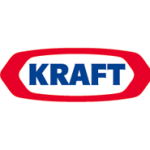
The table below illustrates Kraft Foods SWOT analysis template Strengths 1. Strong brand portfolio comprising popular brands such as Philadelphia Cream Cheese, Velveeta, Oscar Mayer and others. 2. High level of brand awareness in the global marketplace 3. International presence in more than 70 countries 4. Effective sponsorship of popular sports events 5. The presence of sophisticated global distribution network Weaknesses 1. The recall of Original flavor of Kraft Macaroni & Cheese Dinner in 2015 due to the risk of small pieces of metal in boxes damaged the brand image 2. Declining profit margin due to intensifying competition 3. Difficulties in sustaining competitive advantage 4. Higher costs of products compared to competition 5. Gaps in capabilities of the company Opportunities 1. Brand extension into pet food 2. Enhancing focus on health aspects of Kraft Foods products 3. Engagement in efficient CSR programs and initiatives to restore positive image of the brand 4. Entering into strategic cooperation with other companies in catering industry 5. Increasesing the effectiveness of social media marketing Threats 1. Increasing consumer health awareness has negative implications on confectionary segment 2. Decline of profit from international operations due to strengthening USD 3. Emerging competition from developing countries 4. Changes in regulations in the good industry 5. Changes in consumer tastes and preferences How to use Kraft Foods SWOT Analysis template above Expand each point above into one or more paragraphs with discussions and analysis. Additional points related to Kraft Foods strengths, weaknesses, opportunities and threats not listed above can also be included if you think they are relevant points and add value to the work. You will need to support your arguments with references from reliable sources such as annual report of the company, industry journals and magazines and government publications. Your discussions will need to include statistical data and…
By John Dudovskiy
Category: Catering
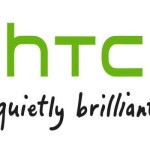
Below is HTC SWOT analysis template Strengths 1. Highest quality for competitive prices 2. Consistent pipeline of new products 3. An extensive range of product portfolio comprising more than 40 types of smartphones 4. Rapidly increasing popularity in the global scale 5. HTC products received numerous awards and recognitions from independent parties and media outlets Weaknesses 1. Weaker brand awareness compared to major competitors such as Apple and Samsung 2. Lack of effectiveness in the development and implementation of the marketing strategy 3. Absence of own operating system (OS) and software, making the company dependent on third party software providers 4. Weaker network of global shipment compared to major established market players 5. Gaps in capabilities of the company Opportunities 1. Development of in-house OS and software 2. Improving the effectiveness of marketing strategy in general and viral marketing in particular 3. Benefiting from growing demand for quality application processors 4. Development of innovative products via effective research and development initiatives 5. Reduction of operational costs thanks to creativity and innovations Threats 1. Market saturation in smartphone sector in major countries 2. Emergence of new competitors from developing countries 3. Engagement in patent wars with other major smartphone manufacturers 4. Decreasing product life cycle in consumer electronics industry 5. A risk of financial crisis in Asia How to use HTC SWOT Analysis template above Expand each point above into one or more paragraphs with discussions and analysis. Additional points related to HTC strengths, weaknesses, opportunities and threats not listed above can also be included if you think they are relevant points and add value to the work. You will need to support your arguments with references from reliable sources such as annual report of the company, industry journals and magazines and government publications. Your discussions will…
By John Dudovskiy
Category: Information Technology
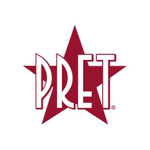
Below is Pret-A-Manger SWOT analysis template Strengths 1. Fresh and healthy food prepared daily 2. Uncompromised approach towards corporate social responsibility 3. Efficient store locations 4. Impressive growth rate of 13.9% in 2015 in the UK[1] 5. Excellent customer services Weaknesses 1. Wastage of unsold food increases operational costs due to daily preparation of fresh food 2. Business model can be easily replicated by competitors 3. Weak global presence with stores only in 6 countries as of 2016 4. Weaker customer loyalty programs compared to Starbucks Coffee and Costa Coffee 5. Fewer choices on the menu compared to the competition Opportunities 1. Increase in the number of vegetarian consumers 2. Formation of strategic collaborations with local farmers 3. Cooperating with celebrity chefs and securing their endorsement 4. Increasing the effectiveness of social media marketing with the focus on viral marketing 5. Pursuing international market expansion strategy Threats 1. The major and strong competitor Starbucks Coffee may shift its focus on freshness and healthiness of its menu 2. Intensification of economic difficulties in countries where Pret-A-Manger operates 3. Changes in consumer taste and preferences 4. Emergence of new café chains offering fresh and healthy food 5. Increase in the costs of fresh ingredients How to use the Pret-A-Manger SWOT Analysis template above Expand each point above into one or more paragraphs with discussions and analysis. Additional points related to Pret-A-Manger strengths, weaknesses, opportunities and threats not listed above can also be included if you think they are relevant points and add value to the work. You will need to support your arguments with references from reliable sources such as annual report of the company, industry journals and magazines and government publications. Your discussions will need to include statistical data and preferably charts and graphs with references to the sources.…
By John Dudovskiy
Category: Catering
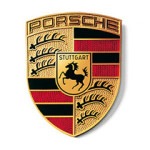
Below is Porsche SWOT analysis template Strengths 1. Advanced brand reputation and high level of customer loyalty 2. Perceived high quality of Porsche cars 3. Highly skilled technical workforce and efficient management 4. Strong strategic alliances with other businesses in auto industry Weaknesses 1. Expensive prices and no offerings for middle class consumers 2. Expensive maintenance and running costs 3. High cost of production (manufacturing is mainly in Stuttgart plant in Germany) 4. Damage to brand image: recall of Porsche Cayenne due to pedal bracket issue Opportunities 1. Increasing investments on research and development to cause disruptive innovation in luxury car segment 2. Shifting manufacturing to China or other developing countries to gain cost advantage in premium car segment 3. Acquiring other premium car manufacturers to fill the gap in the capabilities of the business 4. Focusing on CSR aspect of the business Threats 1. Product recalls in the future due to safety issues 2. Increasing competition from premium car manufacturers in developing countries with access to cost-effective resources 3. Worsening macroeconomic climate in Europe 4. Emergence of CSR-related scandals with detrimental effects on the brand image How to use the Porsche SWOT Analysis template above Expand each point above into one or more paragraphs with discussions and analysis. Additional points related to Porsche strengths, weaknesses, opportunities and threats not listed above can also be included if you think they are relevant points and add value to the work. You will need to support your arguments with references from reliable sources such as annual report of the company, industry journals and magazines and government publications. Your discussions will need to include statistical data and preferably charts and graphs with references to the sources. You can also find many examples for the application of SWOT analysis using the case…
By John Dudovskiy
Category: Automobile

Surprisingly, despite the size and scope of its business activities, Facebook Inc. does not release an annual Corporate Social Responsibility (CSR) report detailing its programs and initiatives. The company has a dedicated Facebook page ‘Green on Facebook’ that regularly announces its charitable programs and CSR activities. Additionally, Facebook has a website at www.sustainability.fb.com dedicated for the same purpose. The table below illustrates the highlights from the latest report for 2015: Categories of CSR activities Facebook Performance Supporting local communities The company hosts farmers market at its Menlo Park headquarters each week providing fresh produce to the Belle Haven and East Palo Alto communities.Facebook has collaborated with Menlo Park Rotary Club to build The Belle Haven Community Garden, where families in the community now have access to 25 planting beds that are free to use.The company has sponsored solar installations on homes in Belle Haven through its partnership with Menlo Spark and Grid Alternatives. Educating and empowering workers Facebook has an employee satisfaction rating of 93 per cent due to competitive pay, informal and empowering organizational culture Labour and human rights It has been noted that “Facebook employees are often placed in roles that cater to their strengths and are encouraged to question and criticize their managers”[1] Employee health and safety Facebook strives to have maximum amount of natural light in its offices and serves local organic food in its kitchens Gender equality and minorities White males constitute 39.1 per cent of employees and black males and females represent only 1.7 per cent of employees. Also, Hispanic males and females represent only 4.3 per cent of the total workforce[2] Environment a) energy consumption b) water consumption c) Waster reduction and recycling d) CO2 emissions The company has announced that its latest data centre in Los Lunas, New Mexico will…
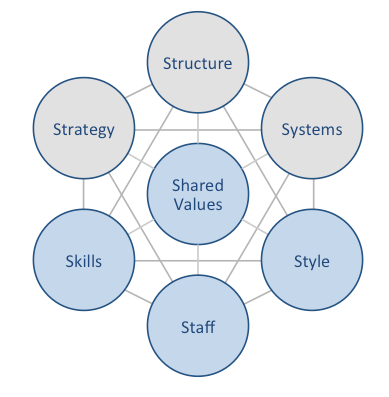
Samsung McKinsey 7S model attempts to explain how seven individual elements of the business can be aligned to increase effectiveness. According to this model strategy, structure and systems represent hard elements, whereas shared values, skills, style and staff are soft elements. McKinsey 7S model argues that there are strong links between elements in a way that a change in one element causes changes in others. As it is illustrated in figure below, shared values are positioned at the core of Samsung McKinsey 7S model, since shared values guide employee behaviour with implications in their performance. Samsung McKinsey 7S model Hard Elements Strategy. Samsung business strategy is mainly based on market readership, i.e. replicating innovations made by market leaders in terms of introducing new products and/or adding innovative features to new products. Samsung’s major competitor, Apple can be specified as company Samsung mainly replicates from. Moreover, Samsung business strategy is based upon scanning and utilising opportunities in the market and new product development on a regular basis. Structure. Samsung organizational structure is divisional and the company is divided into three divisions on the basis of products: IT & Mobile Communications (IM), Consumer Electronics (CE), and Device Solutions (DS). Each division is managed separately according to unique aspects and characteristics of its products. As the outcome of review of optimal organizational structure completed on April 2017, the senior management decided not to shift to holding pattern of organizational structure. Nevertheless, Samsung organizational structure may change in medium term perspective. This is due to a series of scandals the company had to deal with recently, including the imprisonment of Jay Y. Lee, a former Samsung executive and founding family member for his role in bribery and embezzlement. Systems. Samsung’s long-term growth prospects depend on smooth running of a wide range of systems. These…

Facebook McKinsey 7S framework illustrates how seven individual elements of businesses can be aligned to increase effectiveness. According to McKinsey 7S model, structure and systems represent hard elements, whereas shared values, skills, style and staff are soft elements. The framework stresses the presence of strong links between elements in a way that a change in one element causes changes in others. As it is illustrated in figure below, shared values are positioned at the core of Facebook McKinsey 7S framework, since shared values guide employee behaviour with implications in their performance. Facebook McKinsey 7S Framework Hard Elements Strategy. Facebook follows cost leadership business strategy with a particular focus on user experience. According to its mantra “1% is finished”, the social media company develops new products and services and improves its current range of products and services in a continuous manner. Additionally, important elements of Facebook Inc. business strategy include growth via acquisitions and continuous exploration of new ways of site monetization with positive implications for the bottom line. Structure. Facebook Inc. has a hybrid organizational structure that integrates important elements of hierarchical and divisional organizational structures. Elements of hierarchical structure are expressed via presence of multiple levels of management in the company, whereas elements of divisional or matrix organisational structure are evident on the formation of product-based teams on the global scale. The founder, Chairman of the Board and CEO Mark Zuckerberg is the main driving force and the ultimate operational and strategic decision maker in the company. Systems. Facebook Inc. business operations rely on a wide range of organizational systems. The ranges of systems that are the most critical for the social media company include HR system, information system, security system and others. Security system in particular is a critical success factor and it relates to both, company’s own security, as…
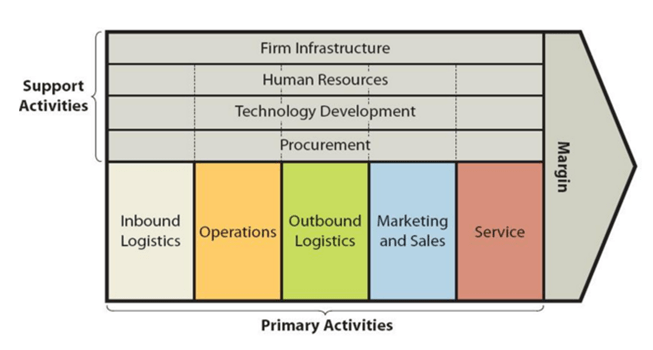
Value chain analysis is a strategic analytical tool that can be applied to analyse business activities to be able to identify those activities that contribute most the overall competitive advantage of the business. Facebook value chain analysis provided below discusses sources of competitive advantage of the social media company by referring to its primary and support business activities. Figure 1 below illustrates the essence of value chain analysis. Figure 1 Facebook Value Chain Analysis Primary Activities Inbound logistics Facebook Inc. inbound logistics refers to ways the company acquires resources and uses according to its needs. The range of resources used by the social media giant includes hardware, various types of technologies and office supplies. Generally, value chain analysis framework analyses the processes of receiving and storing raw materials until their transformation into the final goods. However, due to Facebook Inc.’s business model illustrated in Figure 6 below, tangible resources such as hardware and technology used by the company are only secondary in their nature and the primary resources used to attract the customers are intangible. Specifically, Facebook offers its customers unique intangible ‘products’ of informational nature, i.e. content. From this point of view, inbound logistics of content is highly cost-effective since the content is uploaded by users of in the forms of texts, pictures and videos without any additional costs for the business. Operations Facebook is available in more than 90 different languages, and the company has offices or data centres in more than 30 countries around the world. Moreover, there are five support offices and more than 35 sales offices located globally.[1] Approximately 84.5% of Facebook daily active users are outside the US and Canada.[2] As it is illustrated in Figure 2 below, Facebook operations mainly involve the transformation of raw content into user-friendly format via profile page, timeline,…
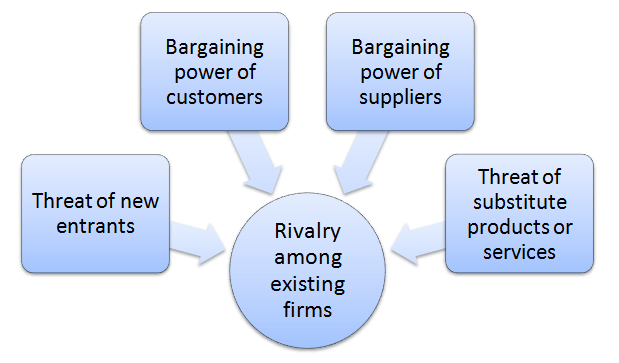
Facebook Inc. Porter’s Five Forces analytical framework assesses an overall extent of competition in the social media industry. Developed by Michael Porter (1979)[1] consists of five individual forces as illustrated in Figure 1 below: Figure 1. Facebook Inc. Porter’s Five Forces Rivalry among existing firms in social media industry is fierce. Alphabet Inc. (Google) is the most prominent competitor for Facebook and Google Adsense and Facebook Ads are two most popular competing platforms for online advertising. Generally, the major players in the industry include Facebook, You Tube, Reddit, Twitter, Instagram, Pinterest, Tumblr, LinkedIn, Yahoo! Answers, Yelp and others. As it is illustrated in Figure 2 below, Facebook is the most popular social networking website in the US with an approximate market share of 42.4 per cent. Most popular social networking websites in the USA (as of August 2016)[2] The rate of the industry growth is immense, diversity within the competition is vast with no switching costs for customers and this fact further intensifies the rivalry among existing market players. Moreover, “there are several regional social networks, such as Renren in China, Mixi in Japan, vKontakte in Russia, etc., and these compete with FB for users in their respective geographies. Increased regulation in certain markets such as China is more beneficial to regional players”.[3] Threat of new entrants into social media industry is significant. Although there are certain industry entry barriers such as capital requirements for marketing and expected retaliation from existing businesses, it is generally easy to built websites and mobile apps. New social media platforms based on innovative ideas and/or integrating innovative features can secure funding from investors to pose a threat to the market share of Facebook, Google+ and other established market players. Taking into account decreasing popularity of Facebook among teens,[4] it can be argued that a new social…
